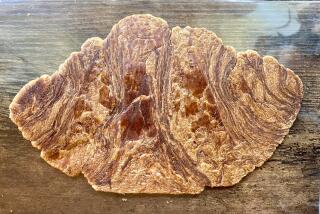Test Kitchen video tips: How to measure ingredients, and why

<p>Los Angeles Times Test Kitchen director Noelle Carter suggests measuring by weight, especially when baking, to ensure the greatest accuracy.</p>
One of the most common questions I receive from readers involves how ingredients are measured in recipes, such as this email from Mary:
“Hi – Re: the recipe for Coffee Doughnut Muffins from the Sweet Butter Restaurant, I’m confused about a couple of the measurements: it calls for 4 cups of flour and states that is 17 ounces. ... 4 cups would be 32 ounces. Also, it says 3-1/2 cups sugar is 24-1/2 oz. when in fact it would be 28 oz. Which is correct? ... I’d appreciate hearing from you since I’m anxious to make them, thanks.”
Her questions aren’t uncommon. Over the years I’ve heard from a number of readers wondering why we give seemingly conflicting measurements for ingredients.
MEASURING BY WEIGHT VERSUS VOLUME
I explained to Mary that we give measurements by both volume and weight with certain recipes, particularly those that involve baking. The volume measure will be in cups and the weight in ounces. This can be confusing, because ounces can be both a volume measurement (fluid ounces) and a weight measurement, and there is no correlation between the two. Though a cup contains 8 fluid ounces, a cup of flour typically weighs 4 1/4 ounces (lightly spooned into the cup and leveled), and a cup of sugar generally weighs 7 ounces.
In the Test Kitchen, we measure many ingredients by weight for consistency. This is because measuring dry ingredients such as flour by volume is tricky. Have you ever measured a cup of flour by volume in a measuring cup and then weighed it? Try it and then do it again a second time. You’ll find that, even with the same person using the same technique and equipment to measure a cup of flour, the weight will vary from cup to cup. Measurement by weight is the only way to be consistent.
All types of flour are measured by weight in the Test Kitchen, as are many other ingredients. Once we are done with testing, we convert those measurements to standardized volume measurements. (I base our volumes on those given by King Arthur Flour, Peter Reinhart and Rose Levy Beranbaum.)
WET VERSUS DRY MEASURING CUPS
While we’re on the subject of measuring, there’s a difference between different types of measuring cups as well. Clear glass measures with a spout or lip for pouring are for liquid measurements such as water, milk or oil. These cups often list both cups and ounces. The ounces given are fluid ounces, and are not to be confused with ounces by weight.
Dry measures, on the other hand, are typically made of plastic or metal, and only give measurements by volume (cup, tablespoon, teaspoon, etc.). These are used for ingredients such as flour, sugar, cocoa powder, rolled oats and even dried fruit.
Using the wrong measure -- say a liquid measure for a dry ingredient -- can give you a false measure, affecting the recipe results. And with baking the science it is, you need to be as exact as possible.
GENERAL TIPS TO KEEP IN MIND WHEN MEASURING
Because these questions are not uncommon with readers newer to baking, I occasionally offer basic measuring and ingredient tips on our blog. Here are some things to keep in mind when you’re ready to tackle a recipe:
-- Use liquid measuring cups for liquid ingredients, and dry measures for dry. Honestly, I can’t stress how important this is; nothing will throw a recipe off more quickly than measuring out your flour in a liquid measuring cup (you can end up with much more than is called for in the recipe). Measuring spoons can be used for both liquid and dry ingredients.
-- Place the measuring cup on a flat, level surface before measuring. This goes for liquid and dry ingredients.
-- Gently spoon -- don’t pack -- flour into the measuring cup. Packing will throw off a recipe by adding more flour than is called for. And don’t scoop the flour using the measuring cup — this will pack the flour.
-- Level off dry ingredients so they’re flush with the top of the measuring spoon or cup. Do this gently with a flat level such as a ruler or the back of a knife.
-- Pack brown sugar into your measuring spoon or cup. Yes, this is the opposite of flour.
-- Finally, follow the recipe exactly as it is written. Changing or substituting ingredients alters the recipe and will almost always alter the results. Especially when it comes to the chemistry of baking.
I forwarded Mary those tips, as well as the video above, and I think she’s ready to tackle those doughnut muffins:
“Oh, thank you so much, I am a longtime cook but a recent ‘baker’ so I wasn’t aware of this difference ... thanks for your help! You’re great!”
Cooking is fun -- at least it should be! No matter how long you’ve been in the kitchen, there is always something new to learn, whether it’s a simple twist on an old technique, or a handy tip to save time and energy. In this series of short videos, I demonstrate a variety of kitchen tips, ranging from how to hold a chef’s knife for maximum control to using a spoon to peel fresh ginger. If you have any gadgets, kitchen tips or questions you’d like me to explore, leave a comment or shoot me an email at noelle.carter@latimes.
Love cooking as much as I do? Follow me @noellecarter
More to Read
Eat your way across L.A.
Get our weekly Tasting Notes newsletter for reviews, news and more.
You may occasionally receive promotional content from the Los Angeles Times.







